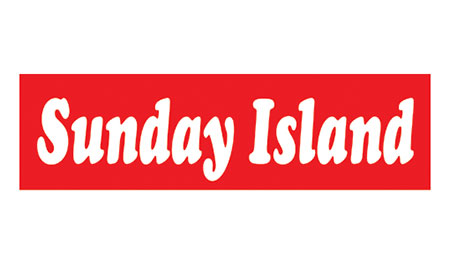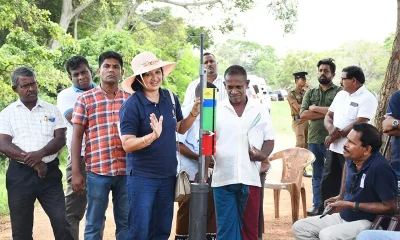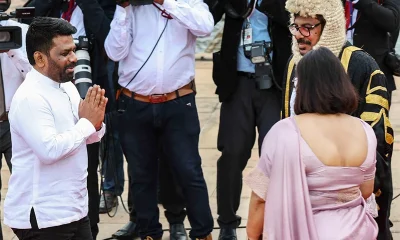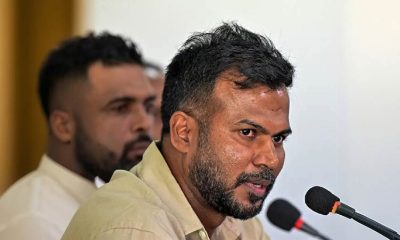Life style
Parliament revisited: creation of a magnificent edifice on the Duwa marsh in Kotte Parliament revisited: creation of a magnificent edifice on the Duwa marsh in Kotte

The structure has a definite Eastern flavour. Bawa commented, “I just wanted the building to fit into the site. You must run with the site, after all, you don’t want to push nature out of the building.”
by Nihal Seneviratne
Wending my way along the old road to what was then known as Kotte, many nostalgic memories keep crowding my mind. This road has now been replaced by a four-lane highway, which leads to the new Sri Jayewardenepura Kotte as the area is now known, along which I commuted for over 33 years.
Most of all I recall the request madeto me by Anandatissa de Alwis, MP for Kotte, to accompany him to view the site for the proposed new Parliament. President Jayewardene had asked the then Speaker to inspect this marshland called Duwa where my friends used to shoot duck a long time ago and assess the suitability of the site.
We had to shed our shoes for gumboots to wade into the marsh. Anandatissa de Alwis was able to report to the president, already totally enamoured by the model of the new Parliament given to him by master architect Geoffrey Bawa, that here was an ideal place for the construction. All credit to Bawa for his enlightened thinking that he could build a Parliament on this marshy site.
On a bright April morning in 1982 at the auspicious hour of 10.13 am, Sri Lanka inaugurated its new capital, Sri Jaywardenepura Kotte to the triumphant sounds of conch shells and reverberating drums. When a third of the construction the new Parliament was done the president followed tradition and deposited nine different gems and other ritual items to invoke the blessings of the deities on the project-
The site popularly known as Kotte would eventually become the sumptuous home of Sri Lankan politicians. The historic Diyawanna Oya, a substantial body of water, was reclaimed from what was once a marshy wasteland. A 300-acre lake was created on which now stands the Parliament of Sri Lanka.
The building was designed by Geoffrey Bawa, Sri Lanka’s best known architect, and it stands as an elegant embodiment of the rich cultural and aesthetic heritage of this land. The silver plated chandelier, weighing one tonne, in the main chamber and skillfully carved mahogany wall outside the Members’ special entrance stand testimony to his work.
Kotte was a capital of Ceylon in the 15th Century, and taking Parliament there as the centerpiece of a new capital was regarded as a return to the past and a methodical strategy for easing congestion of Colombo.
Today, the city of Colombo is still growing from its relatively small size now hosting a yet growing 1.5 million population. What was intended was to make Sri Jayewardenepura the administrative capital of the country and it was so gazetted. It was to house the diplomatic community, government ministries and offices, hospitals and schools; but this has not happened as originally planned. Anandatissa de Alwis suggested the site to President Jayewardene after being told by Geoffrey Bawa that it was eminently suitable. He said, “if we are going to build a new capital, why not return to the capital of the Kings?”
When the Portuguese arrived in 1505, the shrewd Sinhalese tried to keep Kotte’s proximity to the Colombo port a secret. They led the foreigners through a winding excursion on horseback that stretched over seven miles. But the Portuguese saw through the ploy as they could hear their ship guns boom in the harbour. Hence the popular saying “Parangiya Kotte giya” (How the Portuguese went to Kotte).
The building has a huge copper pitch Kandyan roof to disguise its height. In the main pavilion conclave, layers of space on every level are articulated by rectangles of dark wood and glass. Even the stucco columns on the ground floor are unadorned and fuse easily with the simple wooden beams above.
The structure has a definite Eastern flavour. Bawa commented, “We have a marvellous tradition of building in this country which has got lost. It got lost because the people followed outside influences over their own good instincts. I just wanted the building to fit int the site so I opened it into blocks. You must run with the site, after all, you don’t want to push nature out of the building.”
Rupert Scott writing in a Architectural Review states, “most important, the building appears to be in tune with the climate, topography and culture”.
To stand at the entrance to the complex, besides the reflecting pools and Lei race slopes of cascading water, it has to be kept in mind that for centuries the site was a marsh. Constructing the building fell to a consortium of two Mitsui companies. An international team from Japan, Philippines, Malaysia and Singapore along with the skilled labour of masons and carpenters from Sri Lanka all completed the project in very impressive period of 26 months.
Its real heroes are the artisans of Sr Lanka – most of them unacknowledged craftsmen who helped create the magnificent work of art and culture. The opulent chamber, the focal point of the complex, is covered with a shimmering tented ceiling made of thousands of small pressed aluminium pieces linked by a tiny brass sequence. Suspended from the centre of the atrium is the enormous silver plated chandelier with over 500 bulbs in the double pain motif designed by Lankan artist and sculptor Laki Senanayake. He was given only six months to create this and say that he could never have succeeded without the brilliant master craftsman Edwin Perera and his skilled team of craftsmen.
Eighteen silver flags, beams and standards of kings, temples and korales displayed prominently from tall steel posts were crafted by D Wimal Surendra. He was responsible for this work as well as the massive silver door leading to the chamber. The intricately carved square copper door is silver plated and decorated with an elaborate inscription with the words of the preamble of the 1978 Constitution in all three languages -English, Sinhala and Tamil inscribed on it.The walls flanking this ornate door are covered with beautiful line drawings of murals by the late artist LTP Manjusri, a Magsaysay Award winner. The story depicted here is the Selalihini Sandesaya – an eloquent legend of King Parakrama Bahu VI by a famous Sinhala scholar monk of the 15th Century. The Selalihiniya was the bird chosen as the courier to convey to the deity Vibushna in the nearby city of Kelaniya the supplication of the Kotte King for a male heir. The understated elegance of the mural juxtaposes with the lobby walls of the entrance for MPs.
The special entrance, usually off limits to the public, is surrounded by wall space covered with multi-dimensional jungle scenes carved in mahogany by Mahinda Abeysekera. The interior of the main Chamber – the centrepiece or the entire complex – exudes luxury. The plush red carpet, the billowing ceiling, together with black leather chairs for the Members are bathed in indirect lighting.
At the Parliament’s opening ceremony, Dr Anandatissa de Alwis defended such seeming extravagance by rhetorically asking: “Is this unworthy of such a nation that can look towards the world and say we are not made by treaty, we were not created by the United Nations Conference, we were not created by Potsdam, Zurich or Washington. We have a history of over 2,500 years of writing, of poetry, of sculpture, of learning, second to nobody – except the most ancient civilization of my Dravidian friends across the floor of this House.”
These were truly historic and memorable words uttered by the Member of Parliament for Kotte whose valuable contribution must be recorded and not forgotten.
(The writer is a former Secretary General of Parliament)
Life style
Blending additional warmth to festive v season

Pegasus Reef Hotel brought a refreshing twist to the festive season with its much awaited ‘Tropical Christmas’ themed holiday activities by lighting the Christmas Tree and welcoming Santa to the tropics a press release said. The celebrations provided a unique and joyful experience for the whole family, blending the traditional warmth of the festive season with the vibrancy of a tropical setting. The beautifully lit tropical Christmas tree set the tone for both an unforgettable evening and a magical holiday season for all. Guests enjoyed a host of activities including interactive elements for children, including surprise Christmas gifts and photo opportunities with Santa said the release.
The centre piece of the festivities was Santa who made a grand entrance to the event having escaped the cold of the North Pole, to spread the joys of Christmas to young and old in a warm tropical setting. This added to the ambience and brought out that true festive spirit. Tropical-inspired cocktails were available along with delicious food to offer additional flavour to the celebrations.
Commenting on the celebrations, Renuke Coswatte, General Manager of Pegasus Reef Hotel said, “Our Christmas celebrations have always been highly anticipated and has set the tone for the season. This year, by giving festive traditions a tropical twist, we were able to provide our guests, their friends and families a truly unforgettable start to the holiday season. From ‘Santa’s Welcome Party’ coupled with the ‘Tropical Christmas Tree Lighting Ceremony’ and with what we have in store in December, the celebrations will truly be unforgettable.”
Pegasus Reef Hotel has garnered a reputation for hosting exciting festive events over the years, making it a top choice for year-end parties for all. So much so, that the hotels Christmas festivities are eagerly anticipated throughout the year. This year’s ‘Tropical Christmas’ celebration was an ideal opportunity for families, couples and friends to celebrate the season in a warm and inviting setting, that features activities for all.
Lighting of the Christmas Tree and Santa’s welcome party brought the magic of ‘Tropical Christmas’ to life blending traditional holiday festivities added with tropical charm. Pegasus Reef Hotel warmly invites everyone to join in the upcoming seasonal celebrations and create cherished family memories that will last a lifetime.
For more information on future events, contact Pegasus Reef Hotel on 0112049600, follow them on social media at facebook.com/Pegasusreefwattala or www.instagram.com/pegasusreef_wattala and visit their website at www.pegasusreefhotel.com.
Life style
Tis the season to sparkle and shine

This festive season, step into a world of allure at Taj Samudra Colombo, where the spirit of Christmas is brought to life with joy, celebration, and heartwarming experiences said a press release.In the words of Kris Kringle from A Miracle on 34th Street, “Christmas isn’t just a day; it’s a frame of mind.” At Taj Samudra, we embrace this philosophy with a delightful array of offerings designed to spread joy and festive cheer to our guests throughout the season said the release.
From gourmet hampers to festive family dinners, the Christmas carvery market, and the iconic Christmas goodies hut, our kitchen team has created a magical atmosphere for guests to enjoy, share, and celebrate this season of giving.
Luxury Seasonal Hampers and Wine
This Christmas, Taj Samudra offers the ultimate luxury gift experience with customized seasonal hampers. Choose from a selection of premium wines, Champagne, sparkling wines, and exclusive beverages, along with Christmas cakes, puddings, festival chocolates, cheese, seasonal cookies, and more. Curated to perfection, these hampers are the ideal way to indulge your loved ones with festive joy.
Christmas Carvery Counter
Indulge in the flavors of the season at our Christmas Carvery Counter, featuring a homemade charcuterie station brimming with delicious offerings. Enjoy lamb salami, beef salami, smoked lamb, honey ham, chicken cold cut, smoked seer, chicken liver pate and a variety of other delectable treats, perfect for gathering and sharing with friends and family.
Christmas goodies hut at the lobby
Visit the delightful Christmas goodies hut in our lobby, a stunning display of handpicked seasonal treats created by our award-winning chefs. The Goodies Hut, open daily from 10:00 am to 9.00 pm, offers an array of beautifully decorated seasonal goodies and carefully selected gift items—ideal for gifting or enjoying yourself.
Christmas eve celebrations
On the eve of Christmas, join us for a traditional Christmas eve dinner buffet at Ports of Call, where festive delicacies, live action stations, and mouthwatering desserts await. Santa will make a special appearance to delight the young and the young-at-heart. Additionally, enjoy a festive à la carte lunch and dinner at Golden Dragon, Navratna, and YUMI, our stylish Japanese resto-bar.
Christmas Day Festivities
Celebrate Christmas Day with a traditional festive lunch at Ports of Call, featuring all-time favorites such as succulent turkey and a wide selection of Christmas specialties. Our Executive Chef Sajesh Nair and his kitchen brigade will craft the perfect Christmas spread to satisfy every craving.
The said experience an unforgettable musical evening with The Traveleer Sound Duo from Budapest
The release said The lattice lobby lounge for an unforgettable musical experience with The Traveler Sound Duo from Budapest, Hungary. Known for their captivating performances, this talented duo brings a diverse repertoire that spans pop, rock, jazz, and more, offering something for every music lover. Catch them live every Tuesday to Sunday from 7:00 pm to 10:30 pm and enjoy their soulful melodies and dynamic sound in the heart of our vibrant atmosphere. They will also be performing during our renowned Sunday Brunch at Ports of Call, adding the perfect soundtrack to your delightful dining experience.
Unwind and Celebrate at YUMI Japanese Resto Bar and Poolside – Daily Happy Hour from 3:00 pm to 7:00 pm
This holiday season, experience the magic of Christmas at Taj Samudra Colombo, where every corner of the hotel radiates the joy and warmth of the festive season.
Life style
Hot Red looks for Christmas

 Christmas is here and we are eager to begin the celebrations. Everything about December is breathtaking and spectacular, with the rapid shift in the weather and the increasing camaraderie. The cherry on top is the excitement of the New Year itself! The joyous month of the New Year and Christmas is filled with delicious delicacies, elegant decorations, lovely attire, and joyful vibes everywhere. Dressing up for Christmas in warm and fashionable red outfits is something we all love. However, if you are still confused about your Christmas attire, don’t worry, we are here to rescue you. When it comes to fashion and style, no one can do it better than our Bollywood queens. Here are some red-hot looks from our fav Bollywood divas to inspire your Christmas outfits.
Christmas is here and we are eager to begin the celebrations. Everything about December is breathtaking and spectacular, with the rapid shift in the weather and the increasing camaraderie. The cherry on top is the excitement of the New Year itself! The joyous month of the New Year and Christmas is filled with delicious delicacies, elegant decorations, lovely attire, and joyful vibes everywhere. Dressing up for Christmas in warm and fashionable red outfits is something we all love. However, if you are still confused about your Christmas attire, don’t worry, we are here to rescue you. When it comes to fashion and style, no one can do it better than our Bollywood queens. Here are some red-hot looks from our fav Bollywood divas to inspire your Christmas outfits.
Kiara Advani is a true fashionista who can pull off any look. While co-ord sets are among the season’s hottest fashions. In a red-coordinated ensemble, Kiara is offering fashion advice to everyone. Her ensemble is the ultimate Christmas attire since it perfectly combines sexiness and elegance. She is wearing a bustier crop top and a high-rise skirt that accentuate her physique. Bronze bangles and earrings completed Kiara Advani’s outfit as accessories. With this attire, you’ll definitely steal the show.
accessories. With this attire, you’ll definitely steal the show.
Huma’s red formal outfit serves as the ideal Christmas dress inspiration for you if you are not a fan of fancy attire and prefer a sleek and refined look. Whether it’s a casual gathering or a formal function, pantsuits look great on any occasion. In addition to being fashionable, it will also keep you warm. She looks great with a full-sleeved crimson jacket with a wide horizontal white stripe at the bust and straight-fit ankle leggings. For the best appearance, pair it with stud earrings and minimal makeup. Sara is a diva and she is slaying fashion goals in her little red dress with white frills.
If you wish to grab all the attention at the Christmas party then take cues from Sara and choose a red hot bodycon thigh-high slit little dress. Pair it up with a matching red jacket for the glam look and you will be ready to rock the Christmas party.
Among all the divas, Rakul Preet Singh is one of the most fashionable. The actress always dresses well, whether it’s in a gorgeous gown, party attire, or just something that’s too ethnic. Her red corset-style dress is stunning and a must-have for your Christmas wardrobe. It has an off-the-shoulder design, full sleeves, and a fitting nature. To get the glam look, wear it with pointed shoes and diamond drop earrings.
Talking about fashion and style and not mentioning Deepika Padukone is not fair. The queen of Bollywood looks amazing no matter what she wears. If you are tired of wearing dresses and gowns and want to try something different, her vibrant red power suit that exudes boss-woman energy is the ideal outfit inspiration. Her quirky bralette, which had a crisscross neckline, was polished off with a layer of preppy flair thanks to the oversized blazer’s design.
-

 Opinion6 days ago
Opinion6 days agoDegree is not a title!
-

 News5 days ago
News5 days agoInnovative water management techniques revolutionising paddy cultivation in Lanka
-

 Features4 days ago
Features4 days agoThe Degree Circus
-

 Editorial6 days ago
Editorial6 days ago‘Compass’ under the microscope
-

 Sports2 days ago
Sports2 days agoSri Lanka to mend fences with veterans
-

 News6 days ago
News6 days agoArrest of Lankans on terrorism charges in Gujarat: Muslim grouping renews campaign for their release
-

 Opinion4 days ago
Opinion4 days agoHas ‘Compass’ lost direction?
-

 Editorial5 days ago
Editorial5 days agoA supreme irony











